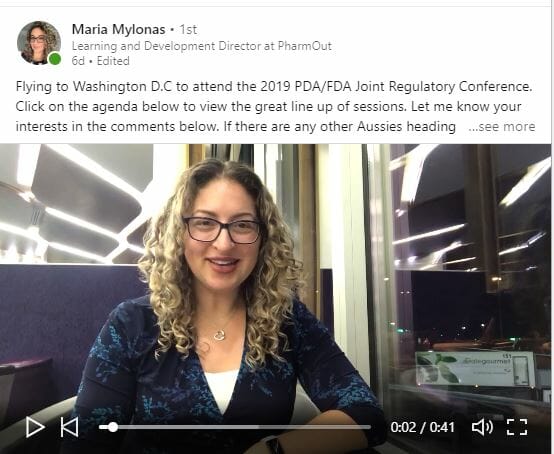Moving forward with the knowledge revolution, GMP eLearning has hit the mainstream. While some GMP compliance topics remain best suited for customised classroom instruction, GMP elearning provides employers with a convenient, economical way to keep contractors and employees up-to-date on GMP compliance matters. Certificate GMP training courses and GMP refresher courses are available-24/7, at a fraction of the price of classroom GMP training costs. These are key reasons some employers choose eLearning vs classroom GMP training, especially for basic GMP knowledge, industry-specific compliance topics, and refresher courses for good manufacturing practices.

eLearning vs Classroom Training | Comparisons: Costs & Benefits
The key benefits of GMP eLearning vs classroom instruction include:
- convenience
- cost
- certificate tracking (assessment results are downloadable/emailable, digital versus a printed document that could get lost before it makes its way to your HR or learning and development department)
- scaling – train multiple employees when they need the training, without disrupting manufacturing or production
- flexible training schedules versus locked-in classroom schedules
- flexible course choices to suit different industries and roles
- no requirement to organise a full-day off, especially if you have several employees needing different courses
- reinforcement of other types of learning (on-the-job and classroom instruction)
- repeatability/access for learning enhancement
- pace — interactive experiences that are self-paced
- access for up to 12 months after the initial enrollment

Knowledge Delivery Benefits
How eLearning has changed for GMP compliance training
If you haven’t used these GMP elearning courses yourself in recent years, you’ll be glad to know that interactive eLearning delivery methods are a far cry from online courses of the past.
Unlike today’s interactive modules, online GMP training course options in the past were limited to:
- long presentations involving significant chunks of text
- boring voice-overs (if any multi-media at all)
- clicking NEXT being the only form of ‘engagement’ (other than getting another cup of coffee, or dozing off due to boredom with the courses)
Today’s eLearning is more multi-sensory.
The user engages with the materials using digital means (moving the mouse, watching a pop-up video or other multimedia experiences, answering Quiz Questions, and more).
Note that interactivity varies depending on the specific course module; but as an industry and training delivery method, GMP eLearning has evolved as a form of digital learning.
Fortunately, today’s eLearning GMP courses rate higher because they offer interactivity (engagement) and instant learning feedback through pop quizzes; all of which remain in the hands of the learner — literally and metaphorically — to meet the learner’s pace and learning style.
This means a learner can review sections of the GMP compliance topic they find unfamiliar or confusing. They also have access to the training for up to 12 months after completion of their assessment(s) for their GMP Training Certificate(s).
Comparing eLearning vs classroom GMP training, a learner may be embarrassed to ask a question, or the instructor may move quickly from topic to topic, leaving some learners behind. Learning gaps related to learning-pace issues are completely alleviated by eLearning modules, as the learner controls how quickly, or slowly, to move through the materials; and can repeat access as often as needed.
Real-life GMP case studies & eLearning scenarios
- Many eLearning GMP courses now illustrate real-life GMP compliance scenarios; and/or educational video links or news stories as examples.
- There are instantly-available assessments (GMP compliance topic learning feedback), to ensure learners DO actually understand the topics presented in the online GMP courses.
- GMP eLearning also enhances the overall learning experience, because module interactivity and repeated training access can help improve retention
- especially when combined into a blended learning approach
- e.g. eLearning combined with on-the-job instructions and classroom GMP training courses
Instant Training Feedback
GMP Online Training Course Quizzes and Formal Assessments
- Learners receive instant feedback through knowledge quizzes, rapidly identifying areas of learning they might have missed
- There’s also the end-of-course Assessment to evaluate the learner’s GMP knowledge on that module’s particular GMP topic
Providing GMP training through several modalities has the potential to improve your employee/contractor GMP compliance behaviours, including during distribution, reporting and record-keeping.
- Ongoing training is one of the GMP requirements – having employees up to date can help reduce common GMP Audit failures
- When formal assessments are passed, Certificates of Completion are also instantly emailed to the learner (which can be forwarded to the Human Resource Director)
These features streamline your record-keeping processes and eliminate the need for manual distribution of Completion Certificates via email and/or photocopies.
Summary | GMP elearning options vs classroom instruction helps provide a seamless method for orientating new employees about GMP requirements in pharmaceutical, veterinary, cannabis plant cultivation and food processing and manufacturing facilities. Certificate GMP elearning modules offer convenience, costs savings and trackable assessment results, with 24/7 access to the training and instant assessment feedback for the learners and employers.
GMP eLearning
Definition of digital training delivery for GMP compliance topics
GMP eLearning is defined as digitally delivered training for compliance knowledge in relation to Good Manufacturing Practices (“GMP”). GMP education topics are delivered through eLearning modules. Access to eLearning requires an internet connection but other options include hosting a learning platform directly on the manufacturer’s infrastructure. Alternatively, eLearning GMP modules can be hosted on an organisation’s privacy-protected internal servers. The primary benefits of eLearning versus classroom GMP delivery include substantial training cost savings, material accessibility, time flexibility, ongoing GMP updates with minimal production disruptions, and a reduction in employee travel expenses relating to GMP compliance training courses.
E-learning vs Classroom Delivery for GMP Compliance Training: Benefits Analysis
Many people think of e-learning as being a convenient ‘second choice’ option to a classroom training session. But research indicates there are additional benefits for e-learning experiences as well as cost savings.

The first benefit of eLearning is an obvious one: PACE.
GMP employees and contractors can take digital training (GMP eLearning) at their own pace.
- This means individual learners are neither slowed-down, nor sped-up, by others in the classroom.
- Fewer classroom distractions can also improve attention and retention; however, this depends partially on the environment the learner chooses to undertake their elearning modules.
- The latest advances in GMP elearning also means that employees can complete their training requirements when travelling between airports to conferences, which is otherwise ‘lost time”.
- The primary benefits of e-learning courses for GMP orientation training, however, relate to training costs, flexibility, individual learning pace and retention.
Here are several additional e-learning benefits you might not have considered when choosing eLearning vs GMP classroom training methods, or in conjunction with specific classroom training (instructor-led GMP courses).
The second benefit of GMP eLearning is Retention.
Effects of relaxed learning environments and instant feedback on GMP knowledge retention.
- Online GMP training delivery formats can improve knowledge accuracy and retention
- in part because they provide a more enjoyable, relaxed learning experience
- in part because they provide more instant feedback
- A relaxed learning environment also means less stress; with stress a risk factor in memory and retention)
The third benefit of eLearning vs classroom GMP instruction is cumulative cost savings
GMP Online Training Prices: comparing e-learning options vs classroom training
- E-learning prices for GMP orientation courses cost less than 5% of sending employees to off-site GMP orientation courses
- Travel costs and employee risks are also reduced (including downtime)
- In medium and large organisations, and during GMP updates and regulatory changes, e-learning can lead to a significant reduction in corporate travel expenses and training costs
- Factor in employee turnover rates and statistics that indicate good orientation programs increase employee retention by up to 75% and e-learning makes a lot of sense from numerous perspectives
Cost Analysis and Comparison of e-Learning vs Classroom Training
- Prices of industry-specific GMP e-learning modules can cost as low as $40 per unit
- GMP orientation training bundles offer even greater price reductions
- Compared to $400 to $4,000 per person for classroom training delivery PLUS travel costs and downtime, GMP e-Learning options make a lot of sense for GMP orientation training
The fourth benefit of eLearning involves scheduling conflict management.
E-learning means less disruption to your manufacturing, cultivation and production schedules.
- Another benefit of e-Learning flexibility is schedule management and time savings
- Sending employees offsite to training courses has certain advantages, but interrupts the workflow
- Production schedules might not synchronize with available GMP classroom training dates, meaning courses booked in advance might need to be missed due to changes in your production needs or staffing levels (compared to online training which can be taken at any time)

Summary of e-learning versus classroom GMP training
Employee GMP Orientations and Refresher GMP Courses (Online)
- The latest e-learning options are growing in popularity with learners and management alike, due to their flexibility and ease of use.
- The net result is that numerous organisations now choose eLearning delivery methods for at least some of their GMP orientation training
- It is often best used in conjunction with some GMP classroom courses and on-the-job training (blended training approaches are shown to have advantages)
For more options and prices of online learning options for GMP e-learning (Orientation Courses), visit the online GMP training courses and eLearning modules page(s).
This article described why online GMP training delivery is growing in popularity in pharmaceutical manufacturing, veterinary medicine, food production, manufacturing, and medicinal cannabis cultivation facilities.
Learn more about e-learning by visiting the available GMP eLearning training courses and prices or contact us for a customised GMP training solution such as classroom training.
References and Journal Publications
Nature Publication Date:
NPJ Science of Learning, Volume 1, Article number: 16011 (2016)
Learning and memory under stress: implications for the classroom
Authors: Susanne Vogel (Medical School Hamburg) & Lars Schwabe (Ruhr-University Bochum, Germany)
Accessed online on 5 June 2019.
Published online 2007 Apr 15.
Stress and Memory: Behavioral Effects and Neurobiological Mechanisms
FORBES Publication Date: 3 Jan 2019
The Bottom Line Of Orientation And Acculturation In Successful Organizations: How Do You Get There?
Description: The effect of on-boarding programs and orientation training in reducing turnover rates. Authors: Forbes Insights Team Accessed online on June 5, 2019.
Last updated on July 6th, 2023 at 10:28 am






